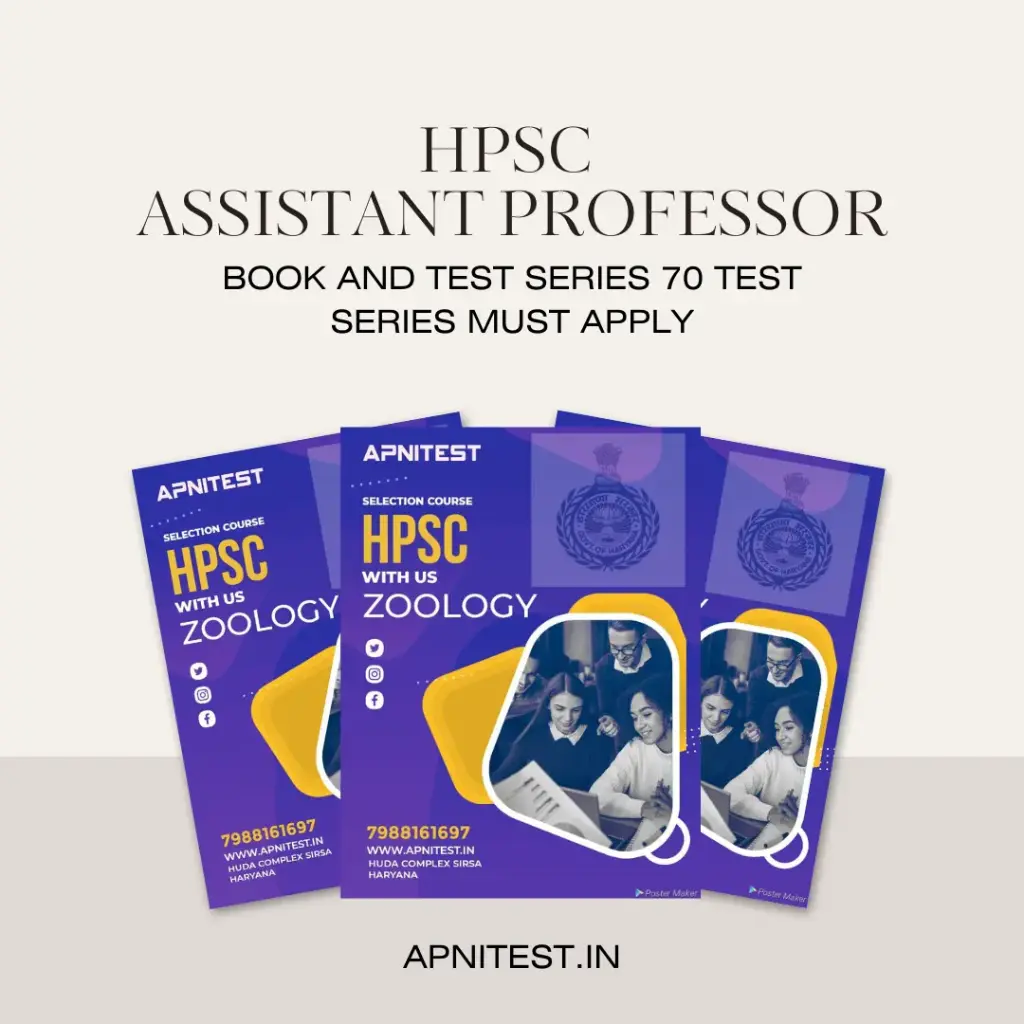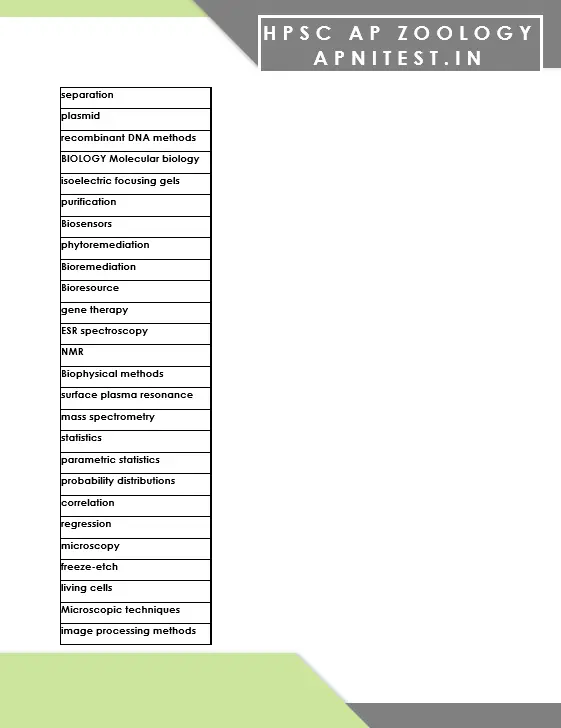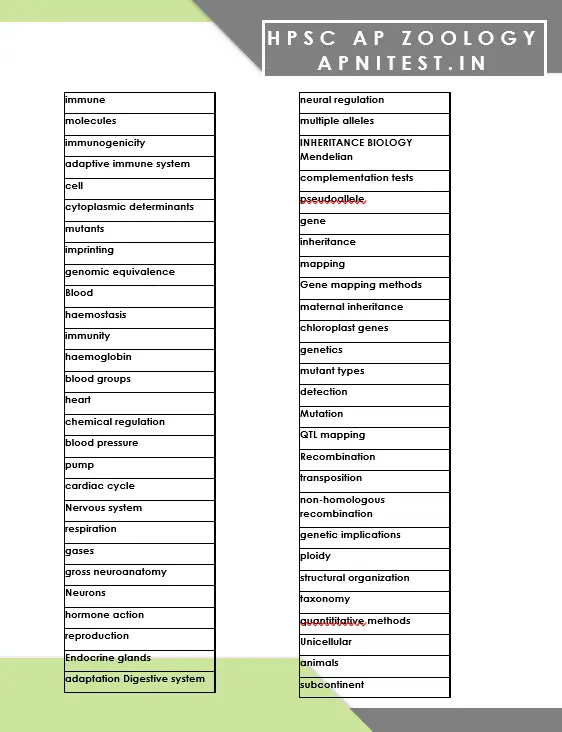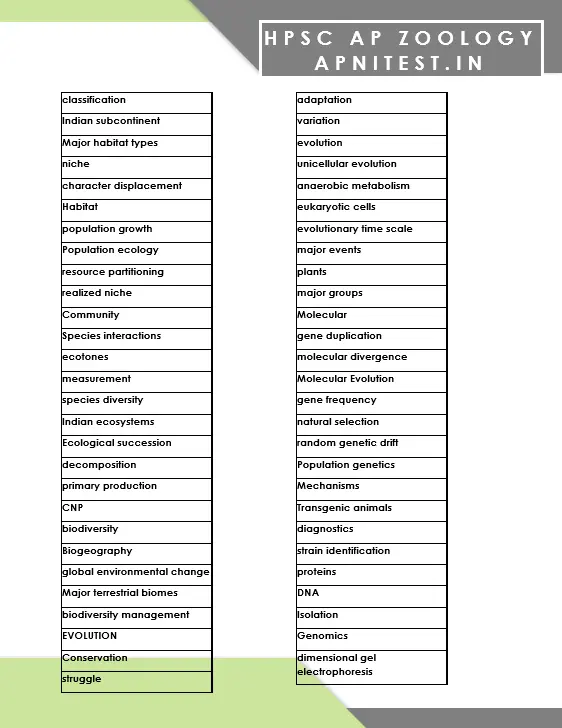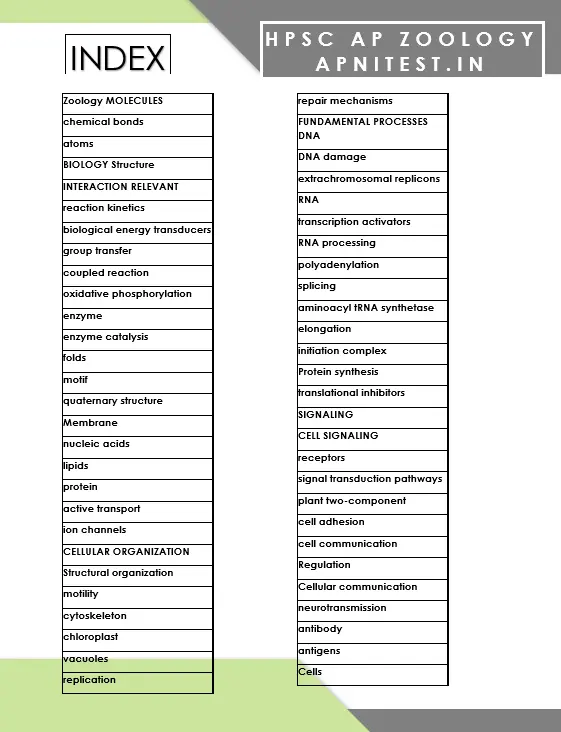HPSC ASSISTANT PROFESSOR AP ZOOLOGY 12 UNIT 13 BOOKLETS AND PYQ BOOKLET , ONLINE TEST SERIES 70+ ALL TYPE OF TEST
HPSC ASSISTANT PROFESSOR ZOOLOGY SYLLABUS-
Syllabus for the Recruitment Test for the post of Assistant Professor (College Cadre) in the subject of Zoology
1. MOLECULES AND THEIR INTERACTION RELEVANT TO BIOLOGY(Assistant Professor Zoology Book)
A. Structure of atoms, molecules and chemical bonds.
B. Composition, structure and function of biomolecules (carbohydrates, lipids, proteins, nucleic acids and vitamins).
C. Stablizing interactions (Van der Waals, electrostatic, hydrogen bonding, hydrophobic interaction, etc.).
D. Principles of biophysical chemistry (pH, buffer, reaction kinetics, thermodynamics, colligative properties).
E. Bioenergetics, glycolysis, oxidative phosphorylation, coupled reaction, group transfer, biological energy transducers.
F. Principles of catalysis, enzymes and enzyme kinetics, enzyme regulation, mechanism of enzyme catalysis, isozymes.
G. Conformation of proteins (Ramachandran plot, secondary, tertiary and quaternary structure; domains; motif and folds).
H. Conformation of nucleic acids (A-, B-, Z-,DNA), t-RNA, micro-RNA).
I. Stability of protein and nucleic acid structures.
J. Metabolism of carbohydrates, lipids, amino acids, nucleotides and vitamins.
2. CELLULAR ORGANIZATION(Assistant Professor Zoology Book)
A. Membrane structure and function: Structure of model membrane, lipid bilayer and membrane protein diffusion, osmosis, ion channels, active transport, ion pumps, mechanism of sorting and regulation of intracellular transport, electrical properties of membranes.
B. Structural organization and function of intracellular organelles: Cell wall, nucleus, mitochondria, Golgi bodies, lysosomes, endoplasmic reticulum, peroxisomes, plastids, vacuoles, chloroplast, structure & function of cytoskeleton and its role in motility.
C. Organization of genes and chromosomes: Operon, interrupted genes, gene families, structure of chromatin and chromosomes, unique and repetitive DNA, heterochromatin, euchromatin, transposons.
D. Cell division and cell cycle: Mitosis and meiosis, their regulation, steps in cell cycle, and control of cell cycle
3. FUNDAMENTAL PROCESSES(Assistant Professor Zoology Book)
A. DNA replication, repair and recombination: Unit of replication, enzymes involved, replication origin and replication fork, fidelity of replication, extrachromosomal replicons, DNA damage and repair mechanisms.
B. RNA synthesis and processing: Transcription factors and machinery, formation of initiation complex, transcription activators and repressors, RNA polymerases, capping, elongation and termination, RNA processing, RNA editing, splicing, polyadenylation, structure and function of different types of RNA, RNA transport.
C. Protein synthesis and processing: Ribosome, formation of initiation complex, initiation factors and their regulation, elongation and elongation factors, termination, genetic code, aminoacylation of tRNA, tRNA-identity, aminoacyl tRNA synthetase, translational proof-reading, translational inhibitors, post- translational modification of proteins.
D. Control of gene expression at transcription and translation level: Regulation of phages, viruses, prokaryotic and eukaryotic gene expression, role of chromatin in regulating gene expression and gene silencing.
4. CELL COMMUNICATION AND CELL SIGNALING(Assistant Professor Zoology Book)
A. Cell signaling: Hormones and their receptors, cell surface receptor, signaling through G-protein coupled receptors, signal transduction pathways, second messengers, regulation of signaling pathways, bacterial and plant two-component signaling systems, bacterial chemotaxis and quorum sensing.
B. Cellular communication: Regulation of hematopoiesis, general principles of cell communication, cell adhesion and roles of different adhesion molecules, gap junctions, extracellular matrix, integrins, neurotransmission and its regulation.
C. Cancer: Genetic rearrangements in progenitor cells, oncogenes, tumor suppressor genes, cancer and the cell cycle, virus-induced cancer, metastasis, interaction of cancer cells with normal cells, apoptosis, therapeutic interventions of uncontrolled cell growth.
D. Innate and adaptive immune system: Cells and molecules involved in innate and adaptive immunity, antigens, antigenicity and immunogenicity. B and T cell epitopes, structure and function of antibody molecules, generation of antibody diversity, monoclonal antibodies, antibody engineering, antigen-antibody interactions, MHC molecules, antigen processing and presentation, activation and differentiation of B and T cells, B and T cell receptors, humoral and cell-mediated immune responses, primary and secondary immune modulation, the complement system, Toll-like receptors, cell-mediated effector functions, inflammation, hypersensitivity and autoimmunity, immune response during bacterial (tuberculosis), parasitic (malaria) and viral (HIV) infections, congenital and acquired immunodeficiencies, vaccines.
5. DEVELOPMENTAL BIOLOGY(Assistant Professor Zoology Book)
A. Basic concepts of development: Potency, commitment, specification, induction, competence, determination and differentiation; morphogenetic gradients; cell fate and cell lineages; stem cells; genomic equivalence and the cytoplasmic determinants; imprinting; mutants and transgenics in analysis of development.
B. Gametogenesis, fertilization and early development: Production of gametes, cell surface molecules in sperm-egg recognition in animals; embryo sac development and double fertilization in plants; zygote formation, cleavage, blastula formation, embryonic fields, gastrulation and formation of germ layers in animals; embryogenesis.
C. Morphogenesis and organogenesis in animals: Cell aggregation and differentiation in Dictyostelium; axes and pattern formation in Drosophila, amphibia and chick; organogenesis – vulva formation in Caenorhabditis elegans; eye lens induction, limb development and regeneration in vertebrates; differentiation of neurons, post embryonic development-larval formation, metamorphosis; environmental regulation of normal development; sex determination.
D. Programmed cell death, aging and senescence.(Assistant Professor Zoology Book)
6. SYSTEM PHYSIOLOGY - ANIMAL
A. Blood and circulation: Blood corpuscles, haemopoiesis and formed elements, plasma function, blood volume, blood volume regulation, blood groups, haemoglobin, immunity, haemostasis.
B. Cardiovascular System: Comparative anatomy of heart structure, myogenic heart, specialized tissue, ECG – its principle and significance, cardiac cycle, heart as a pump, blood pressure, neural and chemical regulation of all above.
C. Respiratory system: Comparison of respiration in different species, anatomical considerations, transport of gases, exchange of gases, waste elimination, neural and chemical regulation of respiration.
D. Nervous system: Neurons, action potential, gross neuroanatomy of the brain and spinal cord, central and peripheral nervous system, neural control of muscle tone and posture.
E. Sense organs: Vision, hearing and tactile response.
F. Excretory system: Comparative physiology of excretion, kidney, urine formation, urine concentration, waste elimination, micturition, regulation of water balance, blood volume, blood pressure, electrolyte balance, acid-base balance.
G. Thermoregulation: Comfort zone, body temperature – physical, chemical, neural regulation, acclimatization.
H. Stress and adaptation(Assistant Professor Zoology Book)
I. Digestive system: Digestion, absorption, energy balance, BMR.
J. Endocrinology and reproduction: Endocrine glands, basic mechanism of hormone action, hormones and diseases; reproductive processes, neuroendocrine regulation.
7. INHERITANCE BIOLOGY(Assistant Professor Zoology Book)
A. Mendelian principles: Dominance, segregation, independent assortment, deviation from Mendelian inheritance.
B. Concept of gene: Allele, multiple alleles, pseudoallele, complementation tests.
C. Extensions of Mendelian principles: Codominance, incomplete dominance, gene interactions, pleiotropy, genomic imprinting, penetrance and expressivity, phenocopy, linkage and crossing over, sex linkage, sex limited and sex influenced characters.
D. Gene mapping methods: Linkage maps, tetrad analysis, mapping with molecular markers, mapping by using somatic cell hybrids.
E. Extra chromosomal inheritance: Inheritance of mitochondrial and chloroplast genes, maternal inheritance.
F. Human genetics: Pedigree analysis, lod score for linkage testing, karyotypes, genetic disorders.
G. Quantitative genetics: Polygenic inheritance, heritability and its measurements, QTL mapping.
H. Mutation: Types, causes and detection, mutant types – lethal, conditional, biochemical, loss of function, gain of function, germinal verses somatic mutants, insertional mutagenesis.
I. Structural and numerical alterations of chromosomes: Deletion, duplication, inversion, translocation, ploidy and their genetic implications.
J. Recombination: Homologous and non-homologous recombination, including transposition, site- specific recombination.
8. DIVERSITY OF LIFE FORMS(Assistant Professor Zoology Book)
A. Principles and methods of taxonomy:Concepts of species and hierarchical taxa, biological nomenclature, classical and quantititative methods of taxonomy of plants, animals.
B. Levels of structural organization: Unicellular, colonial and multicellular forms; levels of organization of tissues, organs and systems; comparative anatomy.
C. Outline classification of plants, animals and microorganisms: Important criteria used for classification in each taxon; classification of animals, evolutionary relationships among taxa
D. Natural history of Indian subcontinent: Major habitat types of the subcontinent, geographic origins and migrations of species; common Indian mammals, birds; seasonality and phenology of the subcontinent.
E. Organisms of health and agricultural importance: Common parasites and pathogens of humans, domestic animals and crops.
9. ECOLOGICAL PRINCIPLES(Assistant Professor Zoology Book)
A. The Environment: Physical environment; biotic environment; biotic and abiotic interactions.
B. Habitat and niche: Concept of habitat and niche; niche width and overlap; fundamental and realized niche; resource partitioning; character displacement.
C. Population ecology: Characteristics of a population; population growth curves; population regulation; life history strategies (r and K selection); concept of metapopulation – demes and dispersal, interdemic extinctions, age structured populations.
D. Species interactions: Types of interactions, interspecific competition, herbivory, carnivory, pollination, symbiosis.
E. Community ecology: Nature of communities; community structure and attributes; levels of species diversity and its measurement; edges and ecotones.
F. Ecological succession: Types; mechanisms; changes involved in succession; concept of climax.
G. Ecosystem: Structure and function; energy flow and mineral cycling (CNP); primary production and decomposition; structure and function of some Indian ecosystems: terrestrial (forest, grassland) and aquatic (fresh water, marine, eustarine).
H. Biogeography: Major terrestrial biomes; theory of island biogeography; biogeographical zones of India.
I. Applied ecology: Environmental pollution; global environmental change; biodiversity-status, monitoring and documentation; major drivers of biodiversity change; biodiversity management approaches.
J. Conservation biology: Principles of conservation, major approaches to management, Indian case studies on conservation/management strategy (Project Tiger, Biosphere reserves).
10. EVOLUTION AND BEHAVIOUR(Assistant Professor Zoology Book)
A. Emergence of evolutionary thoughts: Lamarck; Darwin–concepts of variation, adaptation, struggle, fitness and natural selection; Mendelism; spontaneity of mutations; the evolutionary synthesis.
B. Origin of cells and unicellular evolution: Origin of basic biological molecules; abiotic synthesis of organic monomers and polymers; concept of Oparin and Haldane; experiment of Miller (1953); the first cell; evolution of prokaryotes; origin of eukaryotic cells; evolution of unicellular eukaryotes; anaerobic metabolism, photosynthesis and aerobic metabolism.
C. Paleontology and evolutionary history: The evolutionary time scale; eras, periods and epoch; major events in the evolutionary time scale; origins of unicellular and multicellular organisms; major groups of plants and animals; stages in primate evolution including Homo.
D. Molecular Evolution: Concepts of neutral evolution, molecular divergence and molecular clocks; molecular tools in phylogeny, classification and identification; protein and nucleotide sequence analysis; origin of new genes and proteins; gene duplication and divergence.
E. The Mechanisms: Population genetics – populations, gene pool, gene frequency; Hardy- Weinberg law; concepts and rate of change in gene frequency through natural selection, migration and random genetic drift; adaptive radiation and modifications; isolating mechanisms; speciation; allopatricity and sympatricity; convergent evolution; sexual selection; co-evolution.
11. APPLIED BIOLOGY:(Assistant Professor Zoology Book)
A. Application of immunological principles (vaccines, diagnostics). tissue and cell culture methods for plants and animals.
B. Transgenic animals and plants, molecular approaches to diagnosis and strain identification.
C. Genomics and its application to health and agriculture, including gene therapy.
D. Bioresource and uses of biodiversity.
E. Bioremediation and phytoremediation.
F. Biosensors.
12. METHODS IN BIOLOGY(Assistant Professor Zoology Book)
A. Molecular biology and recombinant DNA methods: Isolation and purification of RNA , DNA (genomic and plasmid) and proteins, different separation methods; analysis of RNA, DNA and proteins by one and two dimensional gel electrophoresis, isoelectric focusing gels; molecular cloning of DNA or RNA fragments in bacterial and eukaryotic systems; expression of recombinant proteins using bacterial, animal and plant vectors; isolation of specific nucleic acid sequences; generation of genomic and cDNA libraries in plasmid, phage, cosmid, BAC and YAC vectors; in vitro mutagenesis and deletion techniques, gene knock out in bacterial and eukaryotic organisms; protein sequencing methods, detection of post-translation modification of proteins; DNA sequencing methods, strategies for genome sequencing; methods for analysis of gene expression at RNA and protein level, large scale expression analysis, such as micro array based techniques; isolation, separation and analysis of carbohydrate and lipid molecules; RFLP, RAPD and AFLP technique
B. Histochemical and immunotechniques: Antibody generation, detection of molecules using ELISA, RIA, western blot, immunoprecipitation, floweytometry and immunofluorescence microscopy, detection of molecules in living cells, in situ localization by techniques such as FISH and GISH.
C. Biophysical methods: Analysis of biomolecules using UV/visible, fluorescence, circular dichroism, NMR and ESR spectroscopy, structure determination using X-ray diffraction and NMR; analysis using light scattering, different types of mass spectrometry and surface plasma resonance methods.
D. Statistical Methods: Measures of central tendency and dispersal; probability distributions (Binomial, Poisson and normal); sampling distribution; difference between parametric and non- parametric statistics; confidence interval; errors; levels of significance; regression and correlation;
2
t-test; analysis of variance; X test;; basic introduction to Muetrovariate statistics, etc.
E. Radio-labeling techniques: Properties of different types of radioisotopes normally used in biology, their detection and measurement; incorporation of radioisotopes in biological tissues and cells, molecular imaging of radioactive materialsafety guidelines.
F. Microscopic techniques: Visulization of cells and subcellular components by light microscopy, resolving powers of different microscopes, microscopy of living cells, scanning and transmission microscopes, different fixation and staining techniques for EM, freeze-etch and freeze-fracture methods for EM, image processing methods in microscopy.
1. MOLECULES AND THEIR INTERACTION RELEVANT TO BIOLOGY(Assistant Professor Zoology Book)
A. Structure of atoms, molecules and chemical bonds.
B. Composition, structure and function of biomolecules (carbohydrates, lipids, proteins, nucleic acids and vitamins).
C. Stablizing interactions (Van der Waals, electrostatic, hydrogen bonding, hydrophobic interaction, etc.).
D. Principles of biophysical chemistry (pH, buffer, reaction kinetics, thermodynamics, colligative properties).
E. Bioenergetics, glycolysis, oxidative phosphorylation, coupled reaction, group transfer, biological energy transducers.
F. Principles of catalysis, enzymes and enzyme kinetics, enzyme regulation, mechanism of enzyme catalysis, isozymes.
G. Conformation of proteins (Ramachandran plot, secondary, tertiary and quaternary structure; domains; motif and folds).
H. Conformation of nucleic acids (A-, B-, Z-,DNA), t-RNA, micro-RNA).
I. Stability of protein and nucleic acid structures.
J. Metabolism of carbohydrates, lipids, amino acids, nucleotides and vitamins.
2. CELLULAR ORGANIZATION(Assistant Professor Zoology Book)
A. Membrane structure and function: Structure of model membrane, lipid bilayer and membrane protein diffusion, osmosis, ion channels, active transport, ion pumps, mechanism of sorting and regulation of intracellular transport, electrical properties of membranes.
B. Structural organization and function of intracellular organelles: Cell wall, nucleus, mitochondria, Golgi bodies, lysosomes, endoplasmic reticulum, peroxisomes, plastids, vacuoles, chloroplast, structure & function of cytoskeleton and its role in motility.
C. Organization of genes and chromosomes: Operon, interrupted genes, gene families, structure of chromatin and chromosomes, unique and repetitive DNA, heterochromatin, euchromatin, transposons.
D. Cell division and cell cycle: Mitosis and meiosis, their regulation, steps in cell cycle, and control of cell cycle.
3. FUNDAMENTAL PROCESSES(Assistant Professor Zoology Book)
A. DNA replication, repair and recombination: Unit of replication, enzymes involved, replication origin and replication fork, fidelity of replication, extrachromosomal replicons, DNA damage and repair mechanisms.
B. RNA synthesis and processing: Transcription factors and machinery, formation of initiation complex, transcription activators and repressors, RNA polymerases, capping, elongation and termination, RNA processing, RNA editing, splicing, polyadenylation, structure and function of different types of RNA, RNA transport.
C. Protein synthesis and processing: Ribosome, formation of initiation complex, initiation factors and their regulation, elongation and elongation factors, termination, genetic code, aminoacylation of tRNA, tRNA-identity, aminoacyl tRNA synthetase, translational proof-reading, translational inhibitors, post- translational modification of proteins.
D. Control of gene expression at transcription and translation level: Regulation of phages, viruses, prokaryotic and eukaryotic gene expression, role of chromatin in regulating gene expression and gene silencing.
4. CELL COMMUNICATION AND CELL SIGNALING(Assistant Professor Zoology Book)
A. Cell signaling: Hormones and their receptors, cell surface receptor, signaling through G-protein coupled receptors, signal transduction pathways, second messengers, regulation of signaling pathways, bacterial and plant two-component signaling systems, bacterial chemotaxis and quorum sensing.
B. Cellular communication: Regulation of hematopoiesis, general principles of cell communication, cell adhesion and roles of different adhesion molecules, gap junctions, extracellular matrix, integrins, neurotransmission and its regulation.
C. Cancer: Genetic rearrangements in progenitor cells, oncogenes, tumor suppressor genes, cancer and the cell cycle, virus-induced cancer, metastasis, interaction of cancer cells with normal cells, apoptosis, therapeutic interventions of uncontrolled cell growth.
D. Innate and adaptive immune system: Cells and molecules involved in innate and adaptive immunity, antigens, antigenicity and immunogenicity. B and T cell epitopes, structure and function of antibody molecules, generation of antibody diversity, monoclonal antibodies, antibody engineering, antigen-antibody interactions, MHC molecules, antigen processing and presentation, activation and differentiation of B and T cells, B and T cell receptors, humoral and cell-mediated immune responses, primary and secondary immune modulation, the complement system, Toll-like receptors, cell-mediated effector functions, inflammation, hypersensitivity and autoimmunity, immune response during bacterial (tuberculosis), parasitic (malaria) and viral (HIV) infections, congenital and acquired immunodeficiencies, vaccines.
5. DEVELOPMENTAL BIOLOGY(Assistant Professor Zoology Book)
A. Basic concepts of development: Potency, commitment, specification, induction, competence, determination and differentiation; morphogenetic gradients; cell fate and cell lineages; stem cells; genomic equivalence and the cytoplasmic determinants; imprinting; mutants and transgenics in analysis of development.
B. Gametogenesis, fertilization and early development: Production of gametes, cell surface molecules in sperm-egg recognition in animals; embryo sac development and double fertilization in plants; zygote formation, cleavage, blastula formation, embryonic fields, gastrulation and formation of germ layers in animals; embryogenesis.
C. Morphogenesis and organogenesis in animals: Cell aggregation and differentiation in Dictyostelium; axes and pattern formation in Drosophila, amphibia and chick; organogenesis – vulva formation in Caenorhabditis elegans; eye lens induction, limb development and regeneration in vertebrates; differentiation of neurons, post embryonic development-larval formation, metamorphosis; environmental regulation of normal development; sex determination.
D. Programmed cell death, aging and senescence.(Assistant Professor Zoology Book)
6. SYSTEM PHYSIOLOGY - ANIMAL
A. Blood and circulation: Blood corpuscles, haemopoiesis and formed elements, plasma function, blood volume, blood volume regulation, blood groups, haemoglobin, immunity, haemostasis.
B. Cardiovascular System: Comparative anatomy of heart structure, myogenic heart, specialized tissue, ECG – its principle and significance, cardiac cycle, heart as a pump, blood pressure, neural and chemical regulation of all above.
C. Respiratory system: Comparison of respiration in different species, anatomical considerations, transport of gases, exchange of gases, waste elimination, neural and chemical regulation of respiration.
D. Nervous system: Neurons, action potential, gross neuroanatomy of the brain and spinal cord, central and peripheral nervous system, neural control of muscle tone and posture.
E. Sense organs: Vision, hearing and tactile response.
F. Excretory system: Comparative physiology of excretion, kidney, urine formation, urine concentration, waste elimination, micturition, regulation of water balance, blood volume, blood pressure, electrolyte balance, acid-base balance.
G. Thermoregulation: Comfort zone, body temperature – physical, chemical, neural regulation, acclimatization.
H. Stress and adaptation(Assistant Professor Zoology Book)
I. Digestive system: Digestion, absorption, energy balance, BMR.
J. Endocrinology and reproduction: Endocrine glands, basic mechanism of hormone action, hormones and diseases; reproductive processes, neuroendocrine regulation.
7. INHERITANCE BIOLOGY
A. Mendelian principles: Dominance, segregation, independent assortment, deviation from Mendelian inheritance.
B. Concept of gene: Allele, multiple alleles, pseudoallele, complementation tests.
C. Extensions of Mendelian principles: Codominance, incomplete dominance, gene interactions, pleiotropy, genomic imprinting, penetrance and expressivity, phenocopy, linkage and crossing over, sex linkage, sex limited and sex influenced characters.
D. Gene mapping methods: Linkage maps, tetrad analysis, mapping with molecular markers, mapping by using somatic cell hybrids.
E. Extra chromosomal inheritance: Inheritance of mitochondrial and chloroplast genes, maternal inheritance.
F. Human genetics: Pedigree analysis, lod score for linkage testing, karyotypes, genetic disorders.
G. Quantitative genetics: Polygenic inheritance, heritability and its measurements, QTL mapping.
H. Mutation: Types, causes and detection, mutant types – lethal, conditional, biochemical, loss of function, gain of function, germinal verses somatic mutants, insertional mutagenesis.
I. Structural and numerical alterations of chromosomes: Deletion, duplication, inversion, translocation, ploidy and their genetic implications.
J. Recombination: Homologous and non-homologous recombination, including transposition, site- specific recombination.
8. DIVERSITY OF LIFE FORMS(Assistant Professor Zoology Book)
A. Principles and methods of taxonomy:Concepts of species and hierarchical taxa, biological nomenclature, classical and quantititative methods of taxonomy of plants, animals.
B. Levels of structural organization: Unicellular, colonial and multicellular forms; levels of organization of tissues, organs and systems; comparative anatomy.
C. Outline classification of plants, animals and microorganisms: Important criteria used for classification in each taxon; classification of animals, evolutionary relationships among taxa.
D. Natural history of Indian subcontinent: Major habitat types of the subcontinent, geographic origins and migrations of species; common Indian mammals, birds; seasonality and phenology of the subcontinent.
E. Organisms of health and agricultural importance: Common parasites and pathogens of humans, domestic animals and crops.
9. ECOLOGICAL PRINCIPLES(Assistant Professor Zoology Book)
A. The Environment: Physical environment; biotic environment; biotic and abiotic interactions.
B. Habitat and niche: Concept of habitat and niche; niche width and overlap; fundamental and realized niche; resource partitioning; character displacement.
C. Population ecology: Characteristics of a population; population growth curves; population regulation; life history strategies (r and K selection); concept of metapopulation – demes and dispersal, interdemic extinctions, age structured populations.
D. Species interactions: Types of interactions, interspecific competition, herbivory, carnivory, pollination, symbiosis.
E. Community ecology: Nature of communities; community structure and attributes; levels of species diversity and its measurement; edges and ecotones.
F. Ecological succession: Types; mechanisms; changes involved in succession; concept of climax.
G. Ecosystem: Structure and function; energy flow and mineral cycling (CNP); primary production and decomposition; structure and function of some Indian ecosystems: terrestrial (forest, grassland) and aquatic (fresh water, marine, eustarine).
H. Biogeography: Major terrestrial biomes; theory of island biogeography; biogeographical zones of India.
I. Applied ecology: Environmental pollution; global environmental change; biodiversity-status, monitoring and documentation; major drivers of biodiversity change; biodiversity management approaches.
J. Conservation biology: Principles of conservation, major approaches to management, Indian case studies on conservation/management strategy (Project Tiger, Biosphere reserves).
10. EVOLUTION AND BEHAVIOUR(Assistant Professor Zoology Book)
A. Emergence of evolutionary thoughts: Lamarck; Darwin–concepts of variation, adaptation, struggle, fitness and natural selection; Mendelism; spontaneity of mutations; the evolutionary synthesis.
B. Origin of cells and unicellular evolution: Origin of basic biological molecules; abiotic synthesis of organic monomers and polymers; concept of Oparin and Haldane; experiment of Miller (1953); the first cell; evolution of prokaryotes; origin of eukaryotic cells; evolution of unicellular eukaryotes; anaerobic metabolism, photosynthesis and aerobic metabolism.
C. Paleontology and evolutionary history: The evolutionary time scale; eras, periods and epoch; major events in the evolutionary time scale; origins of unicellular and multicellular organisms; major groups of plants and animals; stages in primate evolution including Homo.
D. Molecular Evolution: Concepts of neutral evolution, molecular divergence and molecular clocks; molecular tools in phylogeny, classification and identification; protein and nucleotide sequence analysis; origin of new genes and proteins; gene duplication and divergence.
E. The Mechanisms: Population genetics – populations, gene pool, gene frequency; Hardy- Weinberg law; concepts and rate of change in gene frequency through natural selection, migration and random genetic drift; adaptive radiation and modifications; isolating mechanisms; speciation; allopatricity and sympatricity; convergent evolution; sexual selection; co-evolution.
11. APPLIED BIOLOGY:(Assistant Professor Zoology Book)
A. Application of immunological principles (vaccines, diagnostics). tissue and cell culture methods for plants and animals.
B. Transgenic animals and plants, molecular approaches to diagnosis and strain identification.
C. Genomics and its application to health and agriculture, including gene therapy.
D. Bioresource and uses of biodiversity.
E. Bioremediation and phytoremediation.
F. Biosensors.
12. METHODS IN BIOLOGY(Assistant Professor Zoology Book)
A. Molecular biology and recombinant DNA methods: Isolation and purification of RNA , DNA (genomic and plasmid) and proteins, different separation methods; analysis of RNA, DNA and proteins by one and two dimensional gel electrophoresis, isoelectric focusing gels; molecular cloning of DNA or RNA fragments in bacterial and eukaryotic systems; expression of recombinant proteins using bacterial, animal and plant vectors; isolation of specific nucleic acid sequences; generation of genomic and cDNA libraries in plasmid, phage, cosmid, BAC and YAC vectors; in vitro mutagenesis and deletion techniques, gene knock out in bacterial and eukaryotic organisms; protein sequencing methods, detection of post-translation modification of proteins; DNA sequencing methods, strategies for genome sequencing; methods for analysis of gene expression at RNA and protein level, large scale expression analysis, such as micro array based techniques; isolation, separation and analysis of carbohydrate and lipid molecules; RFLP, RAPD and AFLP techniques
B. Histochemical and immunotechniques: Antibody generation, detection of molecules using ELISA, RIA, western blot, immunoprecipitation, floweytometry and immunofluorescence microscopy, detection of molecules in living cells, in situ localization by techniques such as FISH and GISH.
C. Biophysical methods: Analysis of biomolecules using UV/visible, fluorescence, circular dichroism, NMR and ESR spectroscopy, structure determination using X-ray diffraction and NMR; analysis using light scattering, different types of mass spectrometry and surface plasma resonance methods.
D. Statistical Methods: Measures of central tendency and dispersal; probability distributions (Binomial, Poisson and normal); sampling distribution; difference between parametric and non- parametric statistics; confidence interval; errors; levels of significance; regression and correlation;
2
t-test; analysis of variance; X test;; basic introduction to Muetrovariate statistics, etc.
E. Radio-labeling techniques: Properties of different types of radioisotopes normally used in biology, their detection and measurement; incorporation of radioisotopes in biological tissues and cells, molecular imaging of radioactive material, safety guidelines.
F. Microscopic techniques: Visulization of cells and subcellular components by light microscopy, resolving powers of different microscopes, microscopy of living cells, scanning and transmission microscopes, different fixation and staining techniques for EM, freeze-etch and freeze-fracture methods for EM, image processing methods in microscopy.
HPSC Assistant Professor Hindi Books(Assistant Professor Zoology Book)
Subject | Books | Author/Publisher | Specialties |
Hindi | Humari Sansad | Subash Kashyap | Detailed information about Indian History |
HPSC Assistant Professor Chemistry Books(Assistant Professor Zoology Book)
Subject | Books | Author/Publisher | Specialties |
Chemistry | Simplified Chemistry | Viraf J. Dalal | Covers all topics; Detailed and simple explanation of concepts |
HPSC Assistant Professor Geography Books(Assistant Professor Zoology Book)
Subject | Books | Author/Publisher | Specialties |
Geography | Certified Physical and Human Geography, India Edition | Oxford India | Includes basic and complex geography of India and the world; Easy to learn concepts |
HPSC Assistant Professor History Books(Assistant Professor Zoology Book)
Subject | Books | Author/Publisher | Specialties |
History | India’s Ancient Past | RS Agarwal | Discusses the significance of Ancient Indian History, origin and growth of civilizations, empire and religions |
HPSC Assistant Professor Economics Books(Assistant Professor Zoology Book)
Subject | Books | Author/Publisher | Specialties |
Economics | Indian Economy | Ramesh Singh | Detailed coverage of all topics in the HPSC Preliminary and Main syllabus |
If you are preparing for the exam then you can download HPSC Assistant Professor Previous Year Paper here!
HPSC Assistant Professor Interview Books(Assistant Professor Zoology Book)
Subject | Books | Author/Publisher | Specialties |
General Knowledge | General Knowledge 2024 | Arihant |
|
Aptitude | Quantitative Aptitude | RS Agarwals |
|
Factors to Consider Before Choosing for HPSC Assistant Professor Books(Assistant Professor Zoology Book)
When selecting books for HPSC Assistant Professor exam preparation, it is essential to consider several factors to ensure you are studying the most effective and relevant material. Here are some key points to keep in mind:
- Ensure the book covers the entire HPSC syllabus comprehensively.
- Choose books by well-known authors or reputable publishers.
- Opt for the most recent editions to stay updated with the latest exam patterns and changes.
- Check if the book provides detailed explanations, solved examples, and practice questions.
- Look for books that include HPSC Assistant Professor previous years' question papers for better understanding and practice.
- Read reviews and seek recommendations from successful candidates or educators.
- Ensure the language is easy to understand and the content is well-organized for efficient learning.
- Check if the book provides access to online resources, mock tests, or supplementary study materials.
Importance of HPSC Assistant Professor Books(Assistant Professor Zoology Book)
The importance of HPSC Assistant Professor books cannot be overstated, as they serve as essential resources for comprehensive exam preparation. These books provide a structured approach to studying, covering the entire syllabus in detail and ensuring candidates grasp key concepts thoroughly. They often include practice questions, previous years' papers, and model answers, helping candidates familiarize themselves with the exam pattern and question types. Quality books also offer insights into effective problem-solving techniques and time management strategies, which are crucial for performing well in the exam. By using these books, candidates can enhance their knowledge, boost their confidence, and significantly improve their chances of success in the HPSC Assistant Professor exam. If you are willing to appear for the Haryana Public Service Commission (HPSC) competitive examination, you will need the right resources to crack it. We have curated a list of some of the best books for the HPSC Assistant Professor exam for you. Find the subject-wise list of books here like books for Hindi, Economics, HPSC Assistant Professor Commerce book, and more. There are plenty of books that the candidates appearing for the examination can refer to, but to crack this difficult examination you will need the best in the market. Candidates should choose a book that offers them with authentic and detailed information.
- You can purchase the books for HPSC Assistant Professor post at a bookstore near you or even online based on your convenience.
- The Haryana Public Service Commission Assistant Professor examination is conducted every year by the commission.
- This year, the commission announced a total of 2424 vacancies for the post of the Assistant Professor.
- To grab a seat for the post of the HPSC Assistant Professor you need to make sure that you have the right tools with you to help you prepare better for this highly regarded and respected post.
HPSC Assistant Professor General Studies Books(Assistant Professor Zoology Book)
Subject | Books | Author/Publisher | Specialties |
General Studies | General Studies Paper 1 | McGraw Hill | Comprehensive Study Material dedicated for HPSC exam preparation |
General Studies Paper 1 for Civil Services Main Examination | LexisNexis | Comprehensive Study Material dedicated for HPSC exam preparation |
HPSC Assistant Professor Commerce Books(Assistant Professor Zoology Book)
Subject | Books | Author/Publisher | Specialties |
Commerce | Human Peritus for Assistant Professor Commerce | Human Peritus | Specifically Prepared for the HPSC examination; Includes previous year question papers; Revised Content based on the changes in exam pattern |
